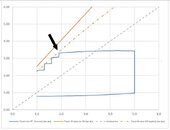For the sake of clarity, i am in no way suggesting that having a dive computer that can vector you in to your preplanned profile means you have to either
1) look at it
2) follow it
All it does is give you a frame of reference. Like having a speedometer in your car, most people simply drive at a speed that "feels about right", very few drive along looking at their speed continuously, but sometimes, it's rather useful to have a known reference instrument where hitting a target becomes more important.
I'm already using multideco for a reference. My deco PC software is calibrated and compared against this, as it's a proven reference, and my embedded deco code (running on an std 32bit ARM development board) is validated by using a software in the loop type approach against the PC software referenced against multideco
Can't help thinking that your plan is to, errm, planny. Dogma's not a great thing in mother nature. Unless you're diving to utter extremes -- bloody silly mega deep bounce dive to pick a tag off a line and spend 18 hours decompressing -- you simply don't need that amount of detail.
The only things you need are the MOD for your gas (which if it's OC it'll be specific for that depth); the minimum gas required after which you drown; the max time to surface which constrains your deco gas requirements (including factoring in failures); and the max runtime (after which the skipper bans you from his boat).
It's that old adage; the first casualty of a battle with the enemy is the plan. Too much planning == too rigid an approach. If you don't have the skills for a specific dive, then don't do that dive, do it after you've gained the skills.





